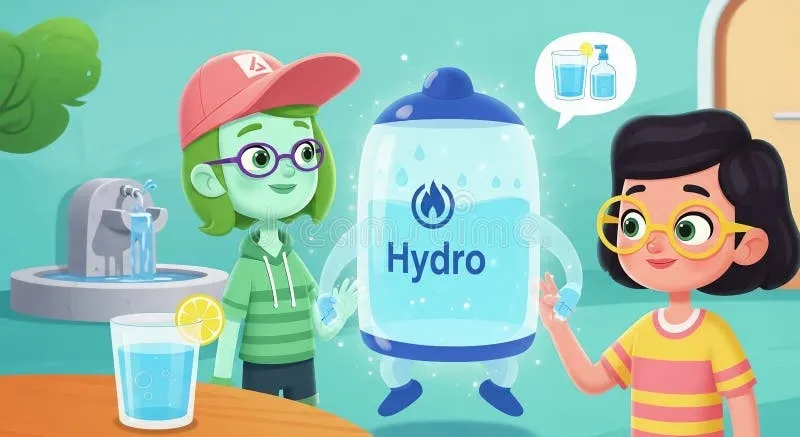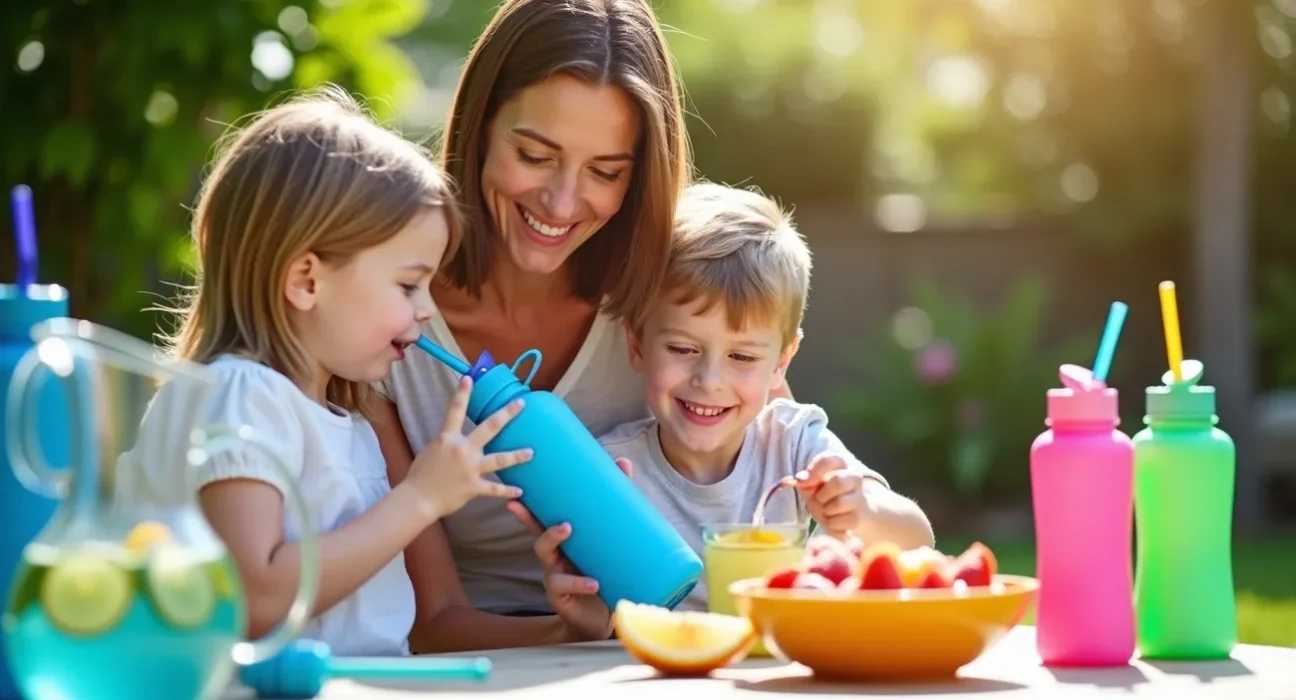Your child’s body contains 60-70% water. This significant fact expresses the amount of water kids should drink daily to stay healthy.
Water serves as a vital component that regulates body temperature, creates bodily fluids, and supports your child’s essential functions. Getting your kids to drink enough water can be challenging. The American Academy of Pediatrics recommends specific daily amounts: 4 cups for children ages 1-3, 5 cups for kids 4-8 years old, and 6-8 cups for older children.
A simple calculation helps determine your child’s fluid needs. Just divide their weight by two to find their daily requirement in fluid ounces. This piece offers practical strategies to keep children hydrated, spot dehydration signs, and understand hydration’s impact on their overall health.
Key Takeaways
Understanding proper hydration needs helps parents ensure their children’s optimal health, cognitive function, and physical development throughout their growing years.
• Age-based water requirements: Toddlers need 4 cups daily, school-age kids need 5-6 cups, and teenagers require 7-8 cups of water per day.
• Early dehydration warning signs: Watch for dry mouth, dark yellow urine, fatigue, and decreased activity levels before severe symptoms develop.
• Make hydration fun and routine: Use colorful water bottles, offer water regularly (not just when thirsty), and include water-rich fruits like watermelon.
• Proper hydration boosts performance: Well-hydrated children perform up to 30% better on cognitive tests and maintain better focus, mood, and energy levels.
• Adjust for activity and weather: Children need extra water during physical activity, hot weather, or illness beyond their baseline daily requirements.
Remember that children’s bodies are 75% water compared to 60% in adults, making consistent hydration even more critical for their development. A simple rule of thumb: divide your child’s weight in pounds by two to estimate their daily fluid ounce needs.
Why Hydration Matters for Kids

Image Source: Dreamstime
Water serves as the lifeblood of your child’s growing body. Your child’s body contains 75% water compared to an adult’s 60%, which makes how much water should kids drink a day a vital part of their development [1]. Good hydration does way beyond the reach and influence of just quenching thirst—it supports every system in your child’s body.
Supports brain and body function
Your child’s brain contains about 75% water, and this makes proper hydration essential for optimal cognitive development [2]. Research shows that mild dehydration can hurt your child’s concentration, memory, and overall cognitive performance [3]. A study revealed that children who managed to keep proper hydration performed by a lot better when multitasking [4]. On top of that, it helps with many more bodily functions such as:
Carrying oxygen and nutrients to cells throughout the body [5]
Supporting joint development and function [5]
Managing healthy blood flow and circulation [5]
Helping remove waste products [5]
Helps regulate temperature and digestion
Children face higher risks of heat-related illnesses because their bodies aren’t as quick at regulating temperature as adults [6]. Good hydration helps your child control temperature through sweating—this becomes critical during exercise or hot weather [7]. Dehydration of just 1-2% body weight can increase physical strain and lower heat tolerance [8].
Water plays a key role in your child’s digestion by breaking down food and absorbing nutrients [9]. It helps create digestive juices like saliva, keeps proper pH balance in the stomach, and prevents constipation—a common problem when children don’t drink enough fluids [9].
Improves focus, mood, and energy
Research shows that well-hydrated students perform up to 30% better on cognitive tests than their dehydrated classmates [10]. Scientists found that children who drank more water showed better working memory and multitasking skills [4].
Your child’s mood depends heavily on proper hydration. Even mild dehydration can make children anxious, irritable, and unable to focus—symptoms you might mistake for behavioral issues [10]. Making sure your child drinks enough water throughout the day can prevent mood swings and keep energy levels steady [4].
Proper hydration becomes especially important during school hours. Studies show that all but one of these children ages 6-19 don’t drink any water during their daily fluid intake [11].
How Much Water Should Children Drink by Age
Children need different amounts of water as they grow. Parents should know how much water should kids drink a day to keep their children properly hydrated. Here’s what you need to know about water intake for each age group.
1–3 years: 4 cups per day
Toddlers aged 1-3 years need about 4 cups (32 ounces) of water daily [12][3][1]. These little ones explore solid foods at this stage, but milk remains their main source of hydration [4]. Starting with this amount helps kids develop healthy drinking habits early.
4–8 years: 5 cups per day
Kids between 4-8 years should drink about 5 cups (40 ounces) of water each day [12][3][1][6]. This amount supports their active lifestyle when they start school and take part in physical activities. Some experts suggest 7 cups [13], but most pediatric organizations recommend 5 cups as the standard amount.
9–13 years: 6 cups per day
Pre-teens aged 9-13 need about 6 cups (48 ounces) of water daily [12][6]. Boys might drink more than girls during these years [13]. Their bodies need extra water because they grow and develop rapidly during this time.
14–18 years: 7–8 cups per day
Teens should drink 7-8 cups (56-64 ounces) of water daily [12][6][14]. Boys and girls have different needs at this age – teen boys might need up to 11 cups (88 ounces) while girls usually need around 8 cups (64 ounces) [14]. These differences happen because of their body composition and physical development.
Adjusting for activity and weather
The basic recommendations above change based on several factors:
Physical activity: Kids need extra water before, during, and after exercise—even when they don’t feel thirsty [12]. Young athletes need much more fluid [5].
Hot or humid weather: Heat and humidity make kids sweat more, so they need additional water [12][1][4].
Altitude: Living or staying at higher altitudes means drinking more water [5].
Recent illness: Kids need extra fluids when recovering from sickness [4].
The quickest way to calculate your child’s water needs is to divide their weight in pounds by two—this gives you the number of ounces they should drink each day [15][6]. To cite an instance, see an 80-pound child who needs about 40 ounces of water daily.
Recognizing Signs of Dehydration
Image Source: iStock
Parents need to spot dehydration early to prevent serious health problems in children. Quick recognition of warning signs will give your child proper kids hydration before things get worse.
Mild symptoms: dry mouth, dark urine, fatigue
Your child’s first signs of dehydration usually show up as a dry or sticky mouth and fewer tears during crying [16]. They might seem more tired, irritable, or less active than normal [17]. They might also pee less often, and their urine could be darker yellow [18]. Kids often don’t feel thirsty until they’re already dehydrated, so thirst alone can signal a problem [19].
Severe symptoms: confusion, sunken eyes, rapid heartbeat
The symptoms get more serious as dehydration gets worse. Look for your child’s sunken eyes or, in babies, a sunken soft spot (fontanelle) on the head [17]. You should also watch for rapid breathing, cool or blotchy hands and feet, extreme sleepiness, and confusion [20]. Yes, it is important to know that severe dehydration can become life-threatening [21] and needs immediate medical care.
How to check hydration using urine color
Your child’s urine color tells you a lot about their hydration. The ideal color should be clear or pale yellow – similar to lemonade [22]. If it looks amber or honey-colored, they have mild dehydration and need more fluids [8]. Dark yellow, orange, or tea-colored urine signals severe dehydration that needs immediate attention [7]. Checking your child’s urine color helps maintain proper hydration for kids between regular water intake.
Simple Ways to Keep Kids Hydrated
Image Source: Amazon.com
Parents often struggle to make their children drink enough water. Here are some practical ways to make hydration fun and turn it into a daily habit.
Offer water regularly, not just when thirsty
Kids don’t usually feel thirsty until dehydration sets in. The best approach is to create regular water breaks throughout the day—during meals, after play, and before bedtime. This helps ensure proper kids hydration, especially around physical activities.
Use fun cups, straws, or water bottles
Kids love picking their own special water bottles with their favorite characters or colors. Bright cups, fun straws, or bottles that light up can make water drinking exciting. Research shows that children who have their own water bottles tend to drink water more frequently throughout the day [23].
Include hydrating foods like fruits and veggies
These fruits and vegetables are packed with water:
Cucumber (96% water) [24]
Watermelon (92% water) [24]
Strawberries (92% water) [24]
Tomatoes (95% water) [24]
Adding these water-rich foods helps boost overall fluid intake naturally.
Limit sugary and artificially sweetened drinks
Sugar accounts for 17% of children’s daily intake—half comes from sweetened beverages [25]. The American Heart Association suggests keeping children’s added sugar below 25 grams daily [26]. Water and milk make better choices than sodas, sports drinks, or fruit drinks.
Model good hydration habits as a parent
Children learn best through example. Keep your water bottle handy, drink water while they watch, and talk about staying hydrated. Family water breaks where everyone drinks together help build lasting healthy habits [27].
Conclusion
Your child’s health and development depends heavily on proper hydration. Children need different amounts of water as they grow – toddlers need 4 cups while teenagers require 8 cups daily. This vital nutrient helps their brain function, regulates body temperature, stabilizes mood, and maintains energy levels.
You need to know how much water your kids should drink each day to build healthy habits early. Kids often feel thirsty only after they’re already dehydrated, so keep water within their reach all day. Look out for signs like dark urine, tiredness, or crankiness that show your child needs to drink more water.
Making hydration fun can transform how your kids view drinking water. They’ll drink more water when you give them cool water bottles, schedule regular water breaks, and offer water-rich foods. Your drinking habits will shape how your children think about water.
Water powers your child’s growing body and mind naturally. When you make sure they drink enough water now, you’re helping them develop good habits that last a lifetime and support their growth today. Something as basic as drinking enough water helps your child learn better, play harder, and grow stronger each day.
References
[1] – https://www.seattlechildrens.org/health-safety/nutrition-wellness/keeping-kids-hydrated/
[2] – https://pmc.ncbi.nlm.nih.gov/articles/PMC6603652/
[3] – https://www.healthychildren.org/English/healthy-living/nutrition/Pages/Choose-Water-for-Healthy-Hydration.aspx
[4] – https://copakids.com/child-healthcare-news/why-hydration-is-crucial-for-children/
[5] – https://scottishriteforchildren.org/hydration-tips-for-young-athletes/
[6] – https://www.childrens.com/health-wellness/hydration-tip-for-your-childs-health-infographic
[7] – https://kidsthatgo.com/yellow-mellow-the-color-of-pee-and-hydration/?srsltid=AfmBOory2vYbbOI393dc_ydHEqhQFoi79pYdR3bLpFHzBIHxSmwRHykc
[8] – https://www.health.nsw.gov.au/environment/beattheheat/Pages/urine-color-chart.aspx
[9] – https://doulton.in/health-wellness/learn-aboutr-how-drinking-water-helps-in-nutrient-absorption-and-digestion-in-kids/?srsltid=AfmBOoprJrGREd1bJYEGNjqWqcPsZJ6Yjgero8duKFYOjCpEKXKDezhv
[10] – https://www.kidsmentalhealth.ca/how-dehydration-silently-affects-your-childs-mood-and-focus/
[11] – https://ucfhealth.com/health-tips/got-water-most-kids-dont/
[12] – https://www.healthdirect.gov.au/hydration-tips-for-children
[13] – https://www.eatright.org/health/essential-nutrients/water/water-how-much-do-kids-need
[14] – https://www.healthline.com/health/how-much-water-should-I-drink
[15] – https://guidingstars.com/healthy-kids/hydration-for-active-kids/
[16] – https://kidshealth.org/en/parents/dehydration.html
[17] – https://my.clevelandclinic.org/health/diseases/9013-dehydration
[18] – https://health.clevelandclinic.org/signs-of-dehydration-in-kids
[19] – https://www.mayoclinic.org/diseases-conditions/dehydration/symptoms-causes/syc-20354086
[20] – https://phoenixchildrens.org/specialties-conditions/dehydration
[21] – https://www.merckmanuals.com/home/children-s-health-issues/dehydration-and-fluid-therapy-in-children/dehydration-in-children
[22] – https://health.choc.org/your-childs-pee-an-ultimate-guide/
[23] – https://www.puttot.com/blogs/singapore-baby-gifts-and-parenting-advice/water-bottles-kids-fun-way-to-keep-hydrated?srsltid=AfmBOoq7sX7tpe8v2xwwcP6AdClMCLfRU75V98tkx0k-XVmRQPiKBodM
[24] – https://onceuponafarmorganics.com/blogs/upon-a-blog/ways-to-help-kids-stay-hydrated?srsltid=AfmBOoozu9P0tyvpRjTkPbygPI8UKXqvXQKJogtyQV5J5kij_gQROScO
[25] – https://www.healthychildren.org/English/healthy-living/nutrition/Pages/How-to-Reduce-Added-Sugar-in-Your-Childs-Diet.aspx
[26] – https://www.childrens.com/health-wellness/effects-of-sugary-drinks-on-your-childs-health-infographic
[27] – https://healthcare.utah.edu/healthfeed/2024/07/your-child-drinking-enough-water

